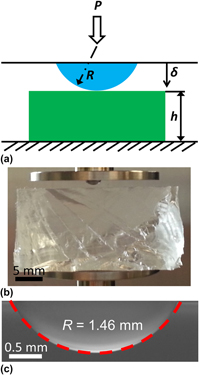Crossref Citations
This article has been cited by the following publications. This list is generated based on data provided by
Crossref.
Wang, Liu
and
Lu, Nanshu
2016.
Conformability of a Thin Elastic Membrane Laminated on a Soft Substrate With Slightly Wavy Surface.
Journal of Applied Mechanics,
Vol. 83,
Issue. 4,
Lu, Nanshu
Yang, Shixuan
and
Wang, Liu
2016.
Stretchable Bioelectronics for Medical Devices and Systems.
p.
31.
Jin, Congrui
and
Ebenstein, Donna M.
2017.
Nanoindentation of compliant materials using Berkovich tips and flat tips.
Journal of Materials Research,
Vol. 32,
Issue. 2,
p.
435.
Yan, Zhuocheng
Pan, Taisong
Xue, Miaomiao
Chen, Changyong
Cui, Yan
Yao, Guang
Huang, Long
Liao, Feiyi
Jing, Wei
Zhang, Hulin
Gao, Min
Guo, Daqing
Xia, Yang
and
Lin, Yuan
2017.
Thermal Release Transfer Printing for Stretchable Conformal Bioelectronics.
Advanced Science,
Vol. 4,
Issue. 11,
Qiao, Shutao
Wang, Liu
Jeong, Hyoyoung
Rodin, Gregory J.
and
Lu, Nanshu
2017.
Suction effects in cratered surfaces.
Journal of The Royal Society Interface,
Vol. 14,
Issue. 135,
p.
20170377.
Xue, Yeguang
Kang, Daeshik
Ma, Yinji
Feng, Xue
Rogers, John A.
and
Huang, Yonggang
2017.
Collapse of microfluidic channels/reservoirs in thin, soft epidermal devices.
Extreme Mechanics Letters,
Vol. 11,
Issue. ,
p.
18.
Lloyd, David
Liu, Xinghui
Boddeti, Narasimha
Cantley, Lauren
Long, Rong
Dunn, Martin L.
and
Bunch, J. Scott
2017.
Adhesion, Stiffness, and Instability in Atomically Thin MoS2 Bubbles.
Nano Letters,
Vol. 17,
Issue. 9,
p.
5329.
Pham, Jonathan T.
Schellenberger, Frank
Kappl, Michael
and
Butt, Hans-Jürgen
2017.
From elasticity to capillarity in soft materials indentation.
Physical Review Materials,
Vol. 1,
Issue. 1,
Wang, Xiufeng
Chen, Shangda
Zhang, Yingxue
Li, Longkang
Xue, Yeguang
Luan, Haiwen
and
Ma, Yinji
2018.
Anti-self-collapse design of reservoir in flexible epidermal microfluidic device via pillar supporting.
Applied Physics Letters,
Vol. 113,
Issue. 16,
Liu, Zheyu
Lu, Hongyu
Zheng, Yelong
Tao, Dashuai
Meng, Yonggang
and
Tian, Yu
2018.
Transient adhesion in a non-fully detached contact.
Scientific Reports,
Vol. 8,
Issue. 1,
Simaite, Aiva
Temple, Brigitte
Amin Karimi, Mohammad
Alizadehyazdi, Vahid
and
Spenko, Matthew
2018.
Understanding the influence of silicone elastomer properties on wedge-shaped microstructured dry adhesives loaded in shear.
Journal of The Royal Society Interface,
Vol. 15,
Issue. 146,
p.
20180551.
Perepelkin, Nikolay V.
Kovalev, Alexander E.
Gorb, Stanislav N.
and
Borodich, Feodor M.
2019.
Estimation of the elastic modulus and the work of adhesion of soft materials using the extended Borodich–Galanov (BG) method and depth sensing indentation.
Mechanics of Materials,
Vol. 129,
Issue. ,
p.
198.
Cai, Shisheng
Li, Hangfei
Ma, Yinji
and
Feng, Xue
2019.
Conformal analysis of epidermal electronics bonded onto wavy bio-tissue by moderately large deflection theory.
Mechanics of Materials,
Vol. 134,
Issue. ,
p.
61.
Simaite, Aiva
and
Spenko, Matthew
2019.
Evaluation of silicone elastomers as structural materials for microstructured adhesives.
Bioinspiration & Biomimetics,
Vol. 14,
Issue. 4,
p.
046005.
Lu, Yinan
Carroll, Jay D.
Long, Kevin N.
and
Long, Rong
2019.
Failure of brittle micro-spherical shells embedded in elastomer matrix under indentation.
Composites Part B: Engineering,
Vol. 173,
Issue. ,
p.
106870.
Wissman, James P.
Sampath, Kaushik
Freeman, Simon E.
and
Rohde, Charles A.
2019.
Capacitive Bio-Inspired Flow Sensing Cupula.
Sensors,
Vol. 19,
Issue. 11,
p.
2639.
Matsuhisa, Naoji
Jiang, Ying
Liu, Zhiyuan
Chen, Geng
Wan, Changjin
Kim, Yeongin
Kang, Jiheong
Tran, Helen
Wu, Hung‐Chin
You, Insang
Bao, Zhenan
and
Chen, Xiaodong
2019.
High‐Transconductance Stretchable Transistors Achieved by Controlled Gold Microcrack Morphology.
Advanced Electronic Materials,
Vol. 5,
Issue. 8,
Cheng, Min
Liu, Ying
Zhong, Bowen
Wang, Hao
Liu, Yangchengyi
Liang, Xu
Chen, Wenxiang
Chen, Shangda
Li, Ming
Xia, Wenjie
and
Wang, Xiufeng
2019.
Superhydrophobic Surface with Controllable Adhesion for Anti‐Roof‐Collapse Application in Flexible Microfluidics.
Advanced Materials Interfaces,
Vol. 6,
Issue. 22,
Zhang, Yingchao
Wang, Fengle
Ma, Yinji
and
Feng, Xue
2019.
Buckling configurations of stiff thin films tuned by micro-patterns on soft substrate.
International Journal of Solids and Structures,
Vol. 161,
Issue. ,
p.
55.
Simaite, Aiva
Amin Karimi, Mohammad
and
Spenko, Matthew
2019.
Crosslinker and catalyst as silicone elastomer bonding enhancers: applications to fabrication of hybrid electrostatic/gecko-like adhesives.
Journal of Micromechanics and Microengineering,
Vol. 29,
Issue. 7,
p.
077001.
